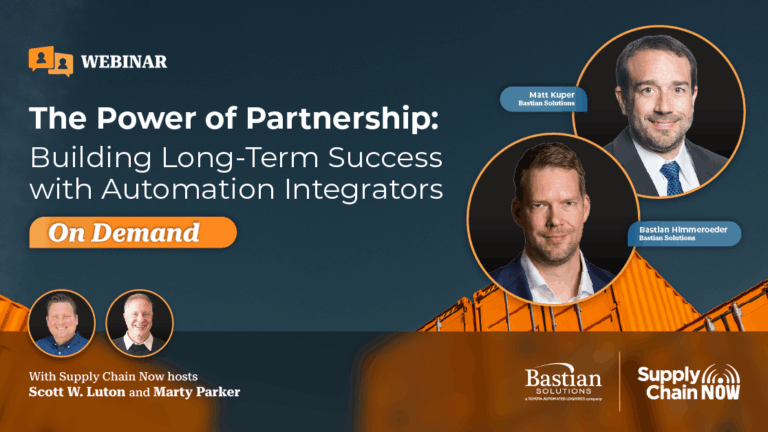
The Power of Partnership in Supply Chain Automation
Key Takeaways from the Supply Chain Now Webinar with Bastian Solutions
In today’s fast-changing world of logistics and manufacturing, one truth is clear: there’s no hiding from automation. Whether you’re a global enterprise or a growing regional player, success depends on choosing the right technology—and, just as importantly, the right partner.
In a recent Supply Chain Now webinar, The Power of Supply Chain Partnerships, hosts Scott Luton and Marty Parker sat down with Matt Kuper and Bastian Himmeroeder from Bastian Solutions, a Toyota Automated Logistics company, for an in-depth conversation about how to unlock the true potential of automation through strong integrator relationships.
Here are a few key takeaways that stood out:
1. Strategic Partnerships Trump One-Off Projects
According to Bastian, the age of “one-and-done” automation projects is over. Today’s complexity demands long-term, strategic relationships between companies and their integrators—ones built on transparency, shared values, and a deep understanding of each other’s goals.
2. Culture Fit Matters as Much as Technology
Matt emphasized that cultural alignment is the first critical element in selecting an integrator. Shared values, open communication, and mutual respect ensure that the partnership thrives well beyond implementation.
3. Experience and Support Drive Success
Choosing a partner with the right industry experience and a commitment to aftercare and continuous improvement can make the difference between a system that simply works and one that evolves with your business. As Marty noted, “You get what you pay for—and aftercare is where that really shows.”
4. Plan for Quick Wins and Long-Term Growth
From retrofitting existing facilities to launching fully automated greenfield sites, Bastian Solutions shared how to balance measurable short-term gains with scalable long-term strategy—all without disrupting the customer experience.
5. Don’t Fear Healthy Debate
Perhaps the most refreshing insight? Great partnerships aren’t about constant agreement. True collaboration means challenging each other’s ideas to find better, smarter solutions.
Want to learn more?
Watch the full conversation for real-world examples of automation done right, including a case study with Polaris that tripled SKU capacity and boosted pick rates by over 50%.
Watch on demand: Register to view the webinar replay »
Related resource: Download Bastian’s Warehouse Operations Strategy Guide »
More Blogs

Why a “Perfect Fit” TMS Beats Feature-Packed Systems

